Simple inkjet-printed color-selective organic photodiodes require no optical filters
Specialized optical sensors are useful in a variety of applications, including visible light communication (VLC), which uses lighting inside buildings for optical communication as a replacement for or enhancement of WiFi. At the InnovationLab (Heidelberg, Germany), scientists at the Karlsruhe Institute of Technology (KIT) have now created printable organic photodiode detectors that can see colors, useful for VLC and other applications. Printing of semiconductor components is a relatively young process, but the optoelectronics industry is already making large investments in the production of printed OLED displays and flexible solar cells. Production of printed photodetectors has also reached the industrial scale—however, previous multicolor printed photodetectors have been complex, relying on optical filters for their wavelength selectivity.
The InnovationLab researchers have developed a general approach for inkjet-printing filter-free, color-selective bulk-heterojunction photodetectors by engineering the ink formulation. The accepting photodetection molecules consist of nonfullerene acceptors (NFAs), which are embedded in a transparent polyindenoflurorene-8-triarylamine (PIF) polymer matrix. Different NFAs produce different color-absorbing bands—for example, in the red and in the blue-green. The NFAs also allow efficient exciton separation and charge extraction at the device’s electrodes. The researchers inkjet-printed a dual-color VLC system as a demonstration of the color-selective organic photodiodes. Two LEDs provided light to the detectors at 530 ±15 and 627 ±10 nm and were separately modulated at low rates (around 10 kHz) for the experiment; signals from a waveform generator, a smartphone, and a personal computer were transmitted over the system. The two signals were clearly detected separately by the two organic photodiodes. The researchers say that their very simple setup could go as high as 3.5 Mbit/s transmission. “High numbers of these photodetectors of any design can be produced on flexible, light materials,” says Noah Strobel, one of the researchers. “Hence, they are particularly suited for mobile devices.” Reference: N. Strobel et al., Adv. Mater. (2020); https://doi.org/10.1002/adma.201908258.
About the Author
John Wallace
Senior Technical Editor (1998-2022)
John Wallace was with Laser Focus World for nearly 25 years, retiring in late June 2022. He obtained a bachelor's degree in mechanical engineering and physics at Rutgers University and a master's in optical engineering at the University of Rochester. Before becoming an editor, John worked as an engineer at RCA, Exxon, Eastman Kodak, and GCA Corporation.

